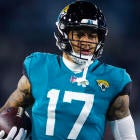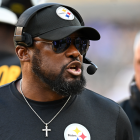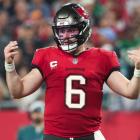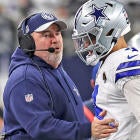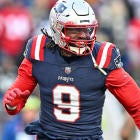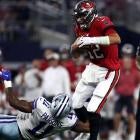It was a popular belief in many circles that the Oakland Raiders won the 2016 offseason. While believing in the team that "won the offseason" is often a dangerous proposition, this year's Raiders seemed different.
The Raiders had shown in 2015 that they had a stable offensive foundation based around Derek Carr, an excellent offensive line protecting him, and weapons like Amari Cooper and Michael Crabtree. And they also had a defense that seemed loaded with potential, especially given the presence of superstar pass-rusher Khalil Mack. When general manager Reggie McKenzie supplemented that potential-laden defensive unit with the signings of Bruce Irvin, Reggie Nelson, and Sean Smith, and the drafting of Karl Joseph, it looked like they had addressed all of their most-pressing issues and were poised to make a run at being one of the league's top-ten defenses.
Instead, the Oakland defense has been nothing short of disastrous through the first two weeks of the 2016 season. The Raiders rank 32nd in yards allowed (1,035), 31st in points allowed (69), and 32nd in Football Outsiders' Defensive VOA (which adjusts performance for down and distance). It's not just a volume thing, either; they're giving up a league-high 8.0 yards per play and 50.4 yards per drive, and have allowed opponents to score on a league-high 57.1 percent of their possessions.
All of which begs the question ...
What, exactly, has gone wrong?
Before addressing that operative question, it's important to examine some context-neutral factors outside the defense's control.
For example, the average starting field position of a team's opponents is largely determined by the offense and special teams. If teams were starting their drives closer to Oakland's end zone, it would be reasonable to expect them to score more points, more often. That, however, has not been the case. In fact, Oakland's defense has enjoyed the seventh-best average starting field position thus far. (Meaning Raider opponents have started their drives farther from the end zone than all but six teams.)
Studies have shown that the field goal conversion rate of opponents is largely out of a team's control, as well. But the Raiders have not only not been disadvantaged by opposing field goal kickers converting at a higher rate than usual, they have arguably been somewhat lucky in that regard so far. Kickers have made just four of six field goal attempts against the Raiders, while league average kick-conversion rate over the last five seasons is 84.0 percent. That would suggest kickers "should" have made five of six field goals against the Raiders (83.3 percent), meaning they'd have allowed even more points.
(It should be noted that the two misses came from 50 and 61 yards, so the Raiders didn't actually get that lucky with those misses. Those are tough kicks that carry a significantly lower conversion rate. Still, Oakland not been adversely affected by the kicking game all that much, if at all.)
The Raiders have not had particularly bad fumble recovery luck, either. Fumble recovery rates tend to regress toward 50 percent over time, and the Raiders have recovered exactly 50 percent of their forced fumbles so far, forcing two and recovering one.
A few bad apples in run defense
With those context-neutral factors working either neutrally or in more in the Raiders' favor than one might expect, the issue really does appear to be the quality of play from (most of) the defenders. They've been pretty brutal at all three levels of defense, against both the run and the pass. That conclusion is supported by both the numbers and the game film.
The Raiders have ceded 227 yards on 51 carries through two games, allowing a 4.5 yards per carry average that ranks tied for 23rd among NFL defenses. That might undersell how poor the Raiders' run defense has really been.
Football Outsiders has several statistics that measure the quality of a team's running game. There's Adjusted Line Yards (which attributes credit to the offensive line based on a percentage of yards gained), Power Success (conversion rate on third or fourth down with two or fewer yards to go), and Stuffed Percentage (percentage of runs stopped at or behind the line of scrimmage).
The Raiders currently rank 30th in Adjusted Line Yards at 4.59, which suggests almost all of their struggles in run defense are due to poor push at the point of attack. They rank 27th in Power Success, but that's only because five other teams have also allowed a 100 percent conversion rate in power situations. And they rank 27th in Stuffed Percentage, stopping only 15 percent of opponents' carries at or behind the line of scrimmage.
Their figures are not being thrown off by one long run, either. The longest run they've allowed is 18 yards; they're simply giving up small-to-medium chunks of yardage on nearly every running play.

A few players up front have been solid or better in their run responsibilities (Khalik Mack -- who has unsurprisingly been very good -- as well as Denico Autry and Bruce Irvin), but run defense is not an individual endeavor quite as much as pass defense is. It takes everyone up front executing and filling the gaps, and a few guys have not been up to snuff.
Rookie defensive tackle Jihad Ward has been blown up in the run game quite a few times, and the rotating cast of interior defenders next to him has been largely ineffectual as well. It doesn't help that Dan Williams, one of the best run defenders in the league the last few seasons, has played only 34 snaps through two games, but his scarce presence doesn't excuse the other guys up front from not fulfilling their responsibilities.
The pass defense has failed across the board
The run defense has been worrying, but of far greater concern is the fact that Oakland has been easily the NFL's worst pass defense so far. This is a passing league, and the Raiders can't go on allowing 404 passing yards a game and still expect to be a competitive team.
Much like the run defense, the numbers here are ugly. Raiders opponents have completed 54 of 76 passes for 808 yards, seven touchdowns (most in the NFL) and only one interception. Only two teams have recorded fewer sacks than the Raiders, who have just two. Oakland ranks 29th in opponent's completion percentage (71.1 percent), 31st in opponent's yards per attempt (10.8), and 32nd in opponent's passer rating (131.4). They're also 32nd in Football Outsiders' pass defense VOA.
Unlike the run defense, the problems are not necessarily limited to one area. A team's pass rush and pass coverage are inextricably linked, and the Raiders have failed badly in both areas so far.
Oakland's two sacks are problematic, especially when you consider that the first of the two was a coverage sack on the first drive of the season-opener. They have just one sack in the remaining 118 minutes and 52 seconds of game time. The second sack, like the first one, came on the opening drive of the Raiders' second game. They went sackless for the remaining 59 minutes and eight seconds of their loss to the Falcons.
It's one thing to not arrive at the quarterback quite soon enough to take him down for a sack, so long as you're still getting pressure on the quarterback and forcing him to make throws under duress. We saw this principle at work on a micro level with Mack. He recorded only four sacks as a rookie in 2014, but he was among the league leaders in pressures with 52, per Pro Football Focus. A year later, his sack total jumped all the way to 15. Get pressure often enough and eventually you'll take the quarterback down before he has a chance to deliver the ball.
But the Raiders are barely getting pressure at all. Per Pro Football Focus tracking, the Raiders recorded a sack, hit, or hurry on 34 percent of their opponents' dropbacks last season. That figured ranked 21st in the NFL. So they went out and signed Irvin to help Mack up front, and they drafted Ward and Shilique Calhoun as well. Instead of rocketing up the pressure rankings, the Raiders have sunk further toward the bottom. Oakland has gotten pressure on just 21.8 percent of opponent's dropbacks so far in 2016, per PFF, 29th in the NFL. The leaguewide pressure rate is down from 35.4 percent to 31 percent so far this season as quarterbacks have gotten the ball out faster than ever before, but that doesn't fully explain Oakland's steep drop-off.
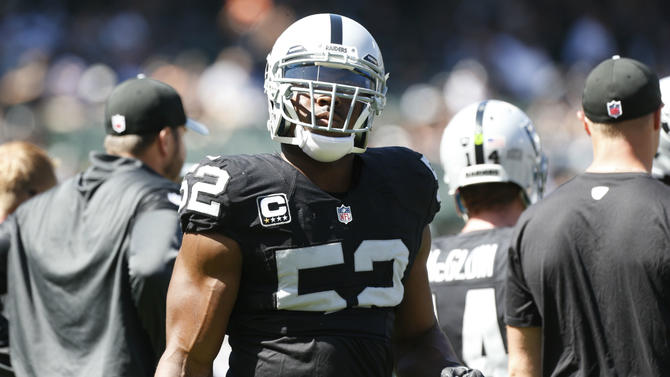
Mack and Irvin are doing their job with 11 combined pressures (some of which have come on the same play), but the rest of the group up front is struggling to get any traction with their rushes. Ward, Calhoun, Autry, Williams, Justin Ellis, and Stacy McGee have combined for 10 pressures between them (again, some of which have come on the same play). A total lack of push up the middle has allowed quarterbacks to throw from a clean pocket on nearly every pass attempt, and they've picked apart the back end of Oakland's defense.
The Raiders have quite simply been torn to shreds down the field in their two games so far. Sean Smith was so bad in Week 1 that he had to be benched (he gave up three catches of 25-plus yards, including a 98-yard touchdown), then got lit up again in Week 2. He's been beaten for three touchdowns in two weeks after giving up an average of just over four per season in his career prior to this year. D.J. Hayden has yet to force an incomplete pass when he's been targeted in coverage. Linebackers Ben Heeney and Malcolm Smith have been relentlessly picked on by tight ends, backs, and slot men.
Poor Keith McGill was helpless as he attempted to cover the likes of Jacob Tamme and Austin Hooper in Week 2. Nelson, one of the NFL's best center-field safeties during his time in Cincinnati, has failed to make it over in time on three different deep passes. The only player really holding his own in coverage is David Amerson (who has an interception and two passes defensed) but even he has yielded eight catches for 80 yards in two games.
How do the Raiders fix this mess?
Some of these myriad issues are more worrisome than others. The Raiders don't really need to be concerned that Mack doesn't have a sack yet, for example. He'll get his. Getting Dan Williams on the field more often should help the run defense as well. Maybe getting first-round pick Karl Joseph onto the field in place of McGill has a domino effect and helps everywhere. He's a huge hitter that can make an impact in the box in the running game and also against receivers coming over the middle. That would help the guys up front and the corners on the outside.
The more concerning issues are probably related to their free agent signings in the secondary. Smith (29 years old) and Nelson (33) have been excellent players for some time, but they're also much closer to the end of their careers than the beginning, and sometimes drop-offs really do happen that quickly. It's reasonable to expect them to bounce back -- it still seems more likely at this point that they rebound than that they're just done -- but it's no guarantee they return to being high-level players. If they can't manage to turn things around, that could adversely affect the defense for the whole season.










